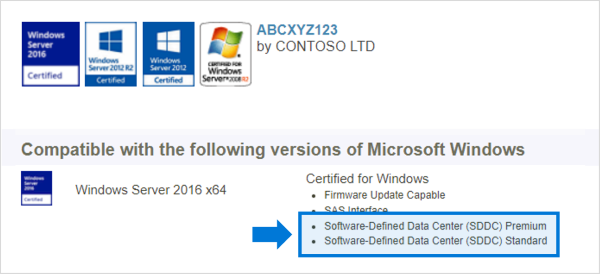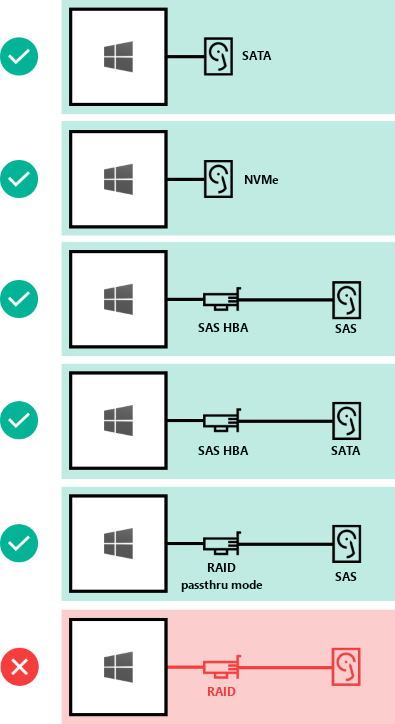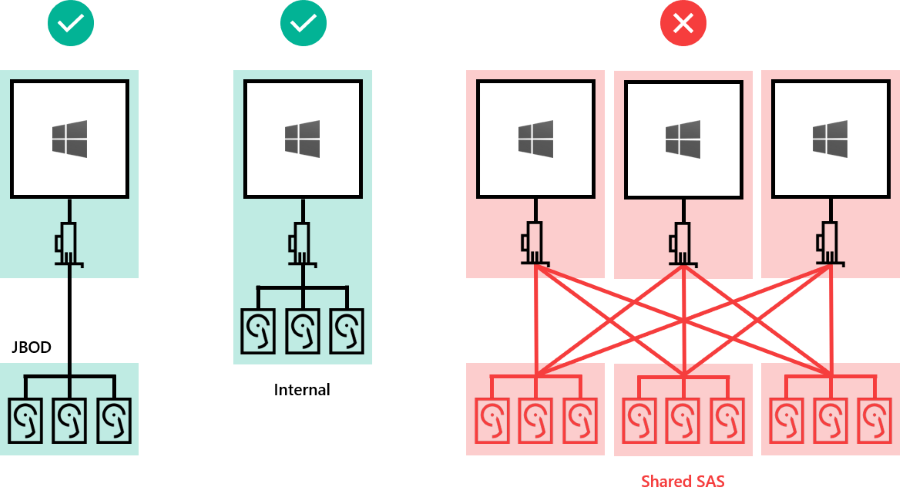Note
Access to this page requires authorization. You can try signing in or changing directories.
Access to this page requires authorization. You can try changing directories.
Storage Spaces Direct in Windows Server enables you to build highly available and scalable storage solutions using industry-standard servers with local storage. Before you deploy, it’s important to ensure your hardware meets the minimum requirements for reliability and performance. This article outlines the supported hardware configurations, recommended practices, and key considerations for both physical and virtual deployments of Storage Spaces Direct in Windows Server. Use this guidance to help plan and validate your environment for optimal results.
With physical hardware, Microsoft recommends purchasing a validated hardware/software solution from our partners, which include deployment tools and procedures. These solutions are designed, assembled, and validated against our reference architecture to ensure compatibility and reliability, so you get up and running quickly.
Tip
Storage Spaces Direct is also used in Azure Local, our operating system designed for hyperconverged deployments with a connection to the cloud. For hardware requirements specific to Azure Local, see System requirements for Azure Local. For available hardware solutions and a sizing tool, visit the Azure Local solutions website.
You can also use Storage Spaces Direct in Hyper-V or Azure virtual machines as described in Using Storage Spaces Direct in guest virtual machine clusters.
Base requirements
Systems, components, devices, and drivers must be certified for the operating system you’re using in the Windows Server Catalog. In addition, we recommend that servers and network adapters also have the Software-Defined Data Center (SDDC) Standard and/or Software-Defined Data Center (SDDC) Premium qualifications (AQs), as shows in the following image. There are over 1,000 components with the SDDC AQs.

The fully configured cluster (servers, networking, and storage) must pass all cluster validation tests per the wizard in Failover Cluster Manager or with the Test-Cluster PowerShell cmdlet.
Important
In scenarios where cluster nodes are implemented, NIC adapters, drivers, and firmware must be an exact match for SET teaming to function properly.
Server requirements
Here are the minimum server requirements:
- Minimum of two servers, maximum of 16 servers.
- Recommended that all servers be the same manufacturer and model.
CPU
Here are the minimum CPU requirements:
- Intel Nehalem or later compatible processor; or
- AMD EPYC or later compatible processor.
Memory
Here are the minimum memory requirements:
- Memory for Windows Server, VMs, and other apps or workloads; plus
- 4 GB of RAM per terabyte (TB) of cache drive capacity on each server, for Storage Spaces Direct metadata.
Boot
Here are the minimum boot requirements:
- Any boot device supported by Windows Server, which now includes SATADOM.
- RAID 1 mirror isn't required, but is supported for boot.
- Recommended: 200 GB minimum size.
Network
Storage Spaces Direct requires a reliable high bandwidth, low latency network connection between each node.
Here are the minimum network requirements:
For minimum interconnect for a small scale 2-3 node cluster:
- 10 Gbps network interface card (NIC), or faster.
- Two or more network connections from each node recommended for redundancy and performance.
Recommended interconnect for high performance, at scale, or deployments of a 4+ node cluster:
- NICs that are remote-direct memory access (RDMA) capable, iWARP (recommended) or RoCE.
- Two or more network connections from each node recommended for redundancy and performance.
- 25 Gbps NIC or faster.
Switched or switchless node interconnects:
- Switched: Network switches must be properly configured to handle the bandwidth and networking type. If you use RDMA that implements the RoCE protocol, network device and switch configuration is even more important.
- Switchless: Nodes can be interconnected using direct connections, avoiding using a switch. Every node is required to have a direct connection with every other node of the cluster.
Drives
Storage Spaces Direct works with direct-attached SATA, SAS, NVMe, or persistent memory (PMem) drives that are physically attached to just one server each. For more help choosing drives, see the Choosing drives and Understand and deploy persistent memory articles.
- SATA, SAS, persistent memory, and NVMe (M.2, U.2, and add-in card) drives are all supported.
- 512n, 512e, and 4K native drives are all supported.
- Solid-state drives must provide power-loss protection.
- Same number and types of drives in every server – see Drive symmetry considerations.
- Cache devices must be 32 GB or larger.
- Persistent memory devices are used in block storage mode.
- When using persistent memory devices as cache devices, you must use NVMe or SSD capacity devices (you can't use HDDs).
- If you're using HDDs to provide storage capacity, you must use storage bus caching. Storage bus caching isn't required when using all-flash deployments.
- NVMe driver is the Microsoft-provided one included in Windows (the driver filename is
stornvme.sys). - Recommended: Number of capacity drives is a whole multiple of the number of cache drives.
- Recommended: Cache drives should have high write endurance: at least 3 drive-writes-per-day (DWPD) or at least 4 terabytes written (TBW) per day – see Understanding drive writes per day (DWPD), terabytes written (TBW), and the minimum recommended for Storage Spaces Direct.
Note
When you use all flash drives for storage capacity, the benefits of storage pool caching are limited. Learn more about the storage pool cache.
Here's how drives can be connected for Storage Spaces Direct:
- Direct-attached SATA drives.
- Direct-attached NVMe drives.
- SAS host-bus adapter (HBA) with SAS drives.
- SAS host-bus adapter (HBA) with SATA drives.
- RAID controller cards directly passing through SAS physical storage devices only.

Important
NOT SUPPORTED: RAID controller cards that don't support direct pass through of SAS physical storage devices or SAN (Fibre Channel, iSCSI, FCoE) storage. Host-bus adapter (HBA) cards must implement simple pass-through mode for any storage devices used for Storage Spaces Direct.
Drives can be:
- Internal to the server
- In an external enclosure ("JBOD") connected to one server. SCSI Enclosure Services (SES) is required for slot mapping and identification. Each external enclosure must present a unique identifier (Unique ID).

Important
NOT SUPPORTED: Shared SAS enclosures connected to multiple servers or any form of multi-path IO (MPIO) where drives are accessible by multiple paths.
Minimum number of drives (excludes boot drive)
The minimum number of capacity drives you require varies with your deployment scenario. If you're planning to use the storage pool cache, there must be at least two cache devices per server.
You can deploy Storage Spaces Direct on a cluster of physical servers or on virtual machine (VM) guest clusters. You can configure your Storage Spaces Direct design for performance, capacity, or balanced scenarios based on the selection of physical or virtual storage devices. Virtualized deployments take advantage of the private or public cloud's underlying storage performance and resilience. Storage Spaces Direct deployed on VM guest clusters allows you to use high availability solutions within virtual environment.
The following sections describe the minimum drive requirements for physical and virtual deployments.
Physical deployments
This table shows the minimum number of capacity drives by type for hardware deployments using Windows Server or Azure Local.
| Drive type (capacity only) | Minimum drives required (Windows Server) | Minimum drives required (Azure Local) |
|---|---|---|
| All persistent memory (same model) | 4 persistent memory | 2 persistent memory |
| All NVMe (same model) | 4 NVMe | 2 NVMe |
| All SSD (same model) | 4 SSD | 2 SSD |
If you use the storage pool cache, there must be at least 2 more drives configured for the cache. The table shows the minimum numbers of drives required for both Windows Server and Azure Local deployments using two or more nodes.
| Drive type present | Minimum drives required |
|---|---|
| Persistent memory + NVMe or SSD | 2 persistent memory + 4 NVMe or SSD |
| NVMe + SSD | 2 NVMe + 4 SSD |
| NVMe + HDD | 2 NVMe + 4 HDD |
| SSD + HDD | 2 SSD + 4 HDD |
Important
The storage pool cache can't be used with Azure Local in a single node deployment.
Virtual deployment
This table shows the minimum number of drives by type for virtual deployments such as Windows Server guest VMs or Windows Server Azure Edition.
| Drive type (capacity only) | Minimum drives required |
|---|---|
| Virtual Hard Disk | 2 |
Tip
To boost the performance for guest VMs when running on Azure Local or Windows Server, consider using the CSV in-memory read cache to cache unbuffered read operations.
If you're using Storage Spaces Direct in a virtual environment, you must consider:
- Virtual disks aren't susceptible to failures like physical drives are, however you're dependent on the performance and reliability of the public or private cloud.
- We recommended using a single tier of low latency / high performance storage.
- Virtual disks must be used for capacity only.
Learn more about deploying Using Storage Spaces Direct in guest virtual machine clusters.
Maximum capacity
The number of servers in the cluster and the type of drives used determines the maximum capacity of Storage Spaces Direct. The following table shows the maximums for Windows Server 2019 or later and Windows Server 2016.
| Maximums | Windows Server 2019 or later | Windows Server 2016 |
|---|---|---|
| Raw capacity per server | 400 TB | 100 TB |
| Pool capacity | 4 PB (4,000 TB) | 1 PB |